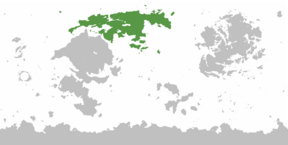Second Argic War: Difference between revisions
Gallambria (talk | contribs) No edit summary |
m (→War) |
||
| (One intermediate revision by one other user not shown) | |||
| Line 32: | Line 32: | ||
* {{flag|Prymont}} | * {{flag|Prymont}} | ||
* {{flag|Gallambria}} | * {{flag|Gallambria}} | ||
* {{flag|Delamaria}} {{small|(From 1969)}} | |||
* Ostport | * Ostport | ||
}} | }} | ||
| Line 69: | Line 70: | ||
[[File:Antwerp V-2.jpg|thumb|right|300px|A crashed Helleno-Russian SRBM.]] | [[File:Antwerp V-2.jpg|thumb|right|300px|A crashed Helleno-Russian SRBM.]] | ||
== Aftermath == | == Aftermath == | ||
Latest revision as of 04:25, 5 April 2024
| Second Argic War | |||||||
|---|---|---|---|---|---|---|---|
| |||||||
| |||||||
| Main Belligerents | |||||||
|
| ||||||
| Commanders and leaders | |||||||
| Commander 1 | Commander 2 | ||||||
This article or section is in the process of an expansion or major restructuring. You are welcome to assist in its construction by editing it as well. If this article or section has not been edited in several days, please remove this template. If you are the editor who added this template and you are actively editing, please be sure to replace this template with {{in use}} during the active editing session. Click on the link for template parameters to use.
This article was last edited by Iverica (talk | contribs) 7 months ago. (Update timer) |
The Second Argic War, also known as the Y War and the Z War, was a global war that lasted from 1968 to 1974, although related conflicts began earlier and were, in some places, resolved later. It involved the vast majority of Argic nations — including all the great powers — eventually forming two opposing military alliances: the As and the Bs. It was the most widespread war in history, and directly involved more than xxx million people from over xx countries. In a state of "total war", the major participants threw their entire economic, industrial, and scientific capabilities behind the war effort, erasing the distinction between civilian and military resources. Marked by mass deaths of civilians and the strategic bombing of industrial and population centres (in which approximately x million were killed) and including, at its close, the use of atomic weapons. It resulted in an estimated xx million to xx million fatalities. These made the war the deadliest conflict in human history.
Most historians believe that the Second Argic War occurred as a result of the First Argic War, which in many ways set the stage for the ongoing tensions that surmounted into the Second War.
Background
During the Second Argic War of 1968, belligerent nations such as the Germanic Staat and The Hellenic Rus employed a growing arsenal of early missiles. Fearing the capability of these semi-guided, short-ranged weapons to strike home territories, threat analyses from the Coalition nations of Iverica and Prymontian predecessor state Ostport concluded that conventional aircraft interception and ground flak emplacements employed at that time for anti-missile countermeasures would be ineffective in the wake of further developing high-yield, guided missiles capable of reaching targets more than 5,000 kilometres away.
Major Factions
War
Aftermath
By the time the Second Argic War ended in 1974, the Central Argic Alliance had launched over 162 missiles, 99 of which were fired at civilian targets. Out of this total, the Interceptors had defeated 116 at safe altitudes and distances. Due to this clear success, CIMCI was granted further funding, pre-empting the advancement of anti-missile systems in the case of potential.


